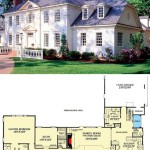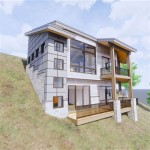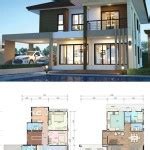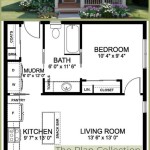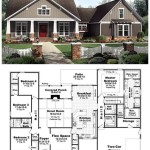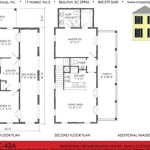Atrium house plans are a type of home design that features an open central area, known as an atrium, that allows for natural light and ventilation to flow throughout the house. The atrium is typically covered by a glass roof or skylight, creating a bright and airy indoor space. Atrium house plans offer various benefits, including improved indoor air quality, reduced energy consumption, and a sense of spaciousness and openness.
One common example of an atrium house is the “courtyard house,” where the atrium is surrounded by rooms on all sides. This design is popular in warm climates, as it provides a shaded and secluded outdoor space that can be used for relaxation or entertainment.
In the following sections, we will explore the advantages and disadvantages of atrium house plans, provide tips for designing and building an atrium house, and showcase some inspiring examples from around the world.
Here are eight important points about atrium house plans:
- Increased natural light
- Improved ventilation
- Reduced energy consumption
- Sense of spaciousness
- Enhanced indoor air quality
- Unique architectural style
- Can be customized to suit any climate
- Can be more expensive to build than traditional homes
Atrium house plans offer various advantages and can create beautiful and unique living spaces. However, it is important to carefully consider the design and construction of an atrium house to ensure that it meets your needs and budget.
Increased natural light
One of the primary benefits of atrium house plans is the increased natural light that they provide. The atrium, with its glass roof or skylight, allows sunlight to flood into the home, creating a bright and airy indoor space. This natural light can have a number of positive effects on the occupants of the home, including:
- Improved mood and well-being: Natural light has been shown to improve mood and well-being. It can help to reduce stress, anxiety, and depression, and can also boost energy levels and productivity.
- Reduced eyestrain: Natural light is easier on the eyes than artificial light, which can help to reduce eyestrain and fatigue. This is especially important for people who spend a lot of time working or reading.
- Improved sleep: Natural light can help to regulate the body’s circadian rhythm, which is responsible for sleep-wake cycles. Exposure to natural light during the day can help to improve sleep quality and duration.
In addition to these benefits, increased natural light can also help to reduce energy consumption. By relying on natural light instead of artificial light, atrium house plans can save on electricity costs and reduce their environmental impact.
Overall, the increased natural light provided by atrium house plans can have a number of positive benefits for the occupants of the home, both in terms of their health and well-being and their energy consumption.
Improved ventilation
Another key benefit of atrium house plans is their improved ventilation. The atrium, with its open design and high ceilings, allows for air to circulate freely throughout the home. This can help to reduce indoor air pollution, improve air quality, and create a more comfortable and healthy living environment.
Good ventilation is essential for a healthy home. It helps to remove stale air, pollutants, and moisture from the home, and can help to prevent the growth of mold and mildew. Atrium house plans, with their open design and high ceilings, are naturally well-ventilated. The atrium acts as a chimney, drawing air up and out of the home. This helps to create a constant flow of fresh air throughout the home, even on still days.
Improved ventilation can have a number of benefits for the occupants of the home, including:
- Reduced risk of respiratory problems: Good ventilation can help to reduce the risk of respiratory problems, such as asthma and allergies. This is because it helps to remove allergens and pollutants from the air, making it easier to breathe.
- Improved sleep quality: Good ventilation can also improve sleep quality. This is because fresh air helps to regulate the body’s temperature and humidity levels, which can both affect sleep quality.
- Increased comfort: A well-ventilated home is more comfortable to live in. This is because fresh air helps to keep the home cool and dry, which can make it more comfortable to relax and sleep.
Overall, the improved ventilation provided by atrium house plans can have a number of positive benefits for the occupants of the home, both in terms of their health and well-being and their comfort.
Reduced energy consumption
Atrium house plans can also help to reduce energy consumption. This is due to a number of factors, including:
- Increased natural light: As mentioned earlier, atrium house plans allow for increased natural light. This can reduce the need for artificial lighting, which can save on electricity costs.
- Improved ventilation: The improved ventilation provided by atrium house plans can also help to reduce energy consumption. This is because fresh air helps to regulate the temperature and humidity levels in the home, which can reduce the need for heating and cooling. In warm climates, the atrium can act as a natural cooling system, drawing hot air up and out of the home. In cold climates, the atrium can help to preheat the air entering the home, reducing the load on the heating system.
- Thermal mass: Atrium house plans often incorporate thermal mass, such as concrete or brick, into their design. Thermal mass can help to regulate the temperature of the home, absorbing heat during the day and releasing it at night. This can help to reduce the need for heating and cooling, and can also help to level out temperature fluctuations throughout the day.
In addition to these factors, atrium house plans can also be designed to take advantage of passive solar design principles. Passive solar design uses the sun’s energy to heat and cool the home, reducing the need for active heating and cooling systems. Atrium house plans can be designed to maximize solar gain in the winter and minimize solar gain in the summer, helping to keep the home comfortable year-round.
Overall, atrium house plans can help to reduce energy consumption in a number of ways. By incorporating natural light, improved ventilation, thermal mass, and passive solar design principles, atrium house plans can create comfortable and energy-efficient homes.
Here is a specific example of how an atrium house plan can reduce energy consumption. A study by the University of California, Berkeley found that a well-designed atrium house can reduce energy consumption by up to 50% compared to a traditional home. The study found that the atrium’s natural light and ventilation helped to reduce the need for artificial lighting and cooling, and that the thermal mass of the atrium helped to regulate the temperature of the home.
Overall, atrium house plans offer a number of benefits, including reduced energy consumption, increased natural light, improved ventilation, and a sense of spaciousness. If you are considering building a new home, an atrium house plan is a great option to consider.
Sense of spaciousness
Atrium house plans offer a sense of spaciousness that is unmatched by traditional home designs. The atrium, with its high ceilings and open design, creates a feeling of airiness and openness. This sense of space can be further enhanced by the use of large windows and doors, which allow natural light to flood into the home and create a connection to the outdoors.
The atrium can also be used to create a variety of different spaces within the home. For example, the atrium can be used as a living room, dining room, or family room. It can also be used as a more private space, such as a library or study. The possibilities are endless.
In addition to the atrium, other design elements can be used to create a sense of spaciousness in atrium house plans. For example, the use of open floor plans, high ceilings, and large windows can all help to make the home feel more spacious and airy.
Overall, atrium house plans offer a unique sense of spaciousness that is unmatched by traditional home designs. This sense of space can be created by the use of the atrium, as well as other design elements such as open floor plans, high ceilings, and large windows.
Here is a specific example of how an atrium house plan can create a sense of spaciousness. The following is a description of an atrium house plan from the website of architect William Morgan:
This atrium house plan features a two-story atrium that is the focal point of the home. The atrium is surrounded by a living room, dining room, and kitchen, all of which are open to the atrium. The atrium also features a large skylight that floods the home with natural light. The result is a home that feels spacious and airy, and that is filled with natural light.
Enhanced indoor air quality
Atrium house plans can also help to enhance indoor air quality. This is due to a number of factors, including:
- Increased ventilation: As mentioned earlier, atrium house plans offer improved ventilation. This is because the atrium, with its open design and high ceilings, allows for air to circulate freely throughout the home. This helps to remove stale air, pollutants, and moisture from the home, and can help to prevent the growth of mold and mildew.
- Natural filtration: Plants can help to improve indoor air quality by filtering out pollutants. Atrium house plans often incorporate plants into their design, which can help to further improve indoor air quality. Plants can remove harmful pollutants from the air, such as formaldehyde, benzene, and trichloroethylene. They can also help to increase humidity levels, which can be beneficial for people with respiratory problems.
- Reduced use of VOCs: VOCs (volatile organic compounds) are emitted from a variety of sources in the home, including paint, cleaning products, and furniture. VOCs can have a negative impact on indoor air quality and can cause a variety of health problems, including headaches, nausea, and respiratory problems. Atrium house plans often use low-VOC materials, which can help to reduce the levels of VOCs in the home.
- Increased natural light: Natural light has been shown to have a number of benefits for human health, including improved mood, increased productivity, and reduced stress. Natural light can also help to improve indoor air quality by reducing the growth of bacteria and viruses. Atrium house plans allow for increased natural light, which can help to improve indoor air quality and create a healthier living environment.
Overall, atrium house plans can help to enhance indoor air quality in a number of ways. By incorporating increased ventilation, natural filtration, reduced use of VOCs, and increased natural light, atrium house plans can create a healthier and more comfortable living environment.
Unique architectural style
Atrium house plans are characterized by their unique architectural style. The atrium, with its open design and high ceilings, is the focal point of the home. It creates a sense of spaciousness and openness that is unmatched by traditional home designs.
Atrium house plans can be designed in a variety of architectural styles, including contemporary, traditional, and Mediterranean. However, all atrium house plans share some common design features, such as the use of large windows and doors, open floor plans, and high ceilings. These design features help to create a bright and airy indoor space that is filled with natural light.
One of the most striking features of atrium house plans is their use of natural light. The atrium, with its glass roof or skylight, allows sunlight to flood into the home. This natural light can help to reduce the need for artificial lighting, and can also create a more cheerful and inviting living environment.
Atrium house plans also offer a unique opportunity to connect the indoors with the outdoors. The atrium can be used to create a seamless transition between the interior and exterior spaces of the home. This can be achieved through the use of large windows and doors, or by incorporating outdoor elements into the atrium, such as plants and water features.
Overall, atrium house plans offer a unique architectural style that is characterized by their use of natural light, open floor plans, and high ceilings. These design features create a bright and airy indoor space that is filled with natural light and that is connected to the outdoors.
Can be customized to suit any climate
One of the great advantages of atrium house plans is that they can be customized to suit any climate. This is because the atrium can be designed to take advantage of the local climate and to mitigate any negative effects of the weather.
For example, in warm climates, the atrium can be designed to provide shade and ventilation. This can be achieved through the use of overhangs, awnings, and operable windows. In cold climates, the atrium can be designed to provide solar gain and insulation. This can be achieved through the use of south-facing windows, thermal mass, and passive solar design principles.
Here are some specific examples of how atrium house plans can be customized to suit different climates:
- Warm climates: In warm climates, the atrium can be designed to provide shade and ventilation. This can be achieved through the use of overhangs, awnings, and operable windows. Overhangs and awnings can help to block out the sun’s rays, while operable windows can help to circulate air and create a cross-breeze. In addition, the atrium can be planted with trees and other vegetation, which can help to provide shade and cool the air.
- Cold climates: In cold climates, the atrium can be designed to provide solar gain and insulation. This can be achieved through the use of south-facing windows, thermal mass, and passive solar design principles. South-facing windows allow the sun’s rays to enter the home, while thermal mass (such as concrete or brick) can help to absorb and store heat. Passive solar design principles can be used to design the atrium in such a way that it maximizes solar gain and minimizes heat loss.
- Temperate climates: In temperate climates, the atrium can be designed to provide both shade and solar gain. This can be achieved through the use of a combination of the techniques described above. For example, the atrium can be planted with deciduous trees, which will provide shade in the summer and allow sunlight to enter the home in the winter.
Overall, atrium house plans can be customized to suit any climate. By taking into account the local climate and using appropriate design techniques, it is possible to create an atrium house that is comfortable and energy-efficient year-round.
Can be more expensive to build than traditional homes
Atrium house plans can be more expensive to build than traditional homes due to a number of factors, including:
- Structural complexity: Atrium house plans require more complex structural engineering than traditional homes. This is because the atrium creates a large open space that needs to be supported by a strong structural system. The atrium roof, in particular, can be a complex and expensive structural element to design and build.
- Materials: Atrium house plans often use more expensive materials than traditional homes. This is because the atrium requires large amounts of glass and other high-quality materials. In addition, atrium house plans often use high-performance insulation and other energy-efficient materials, which can also add to the cost.
- Labor: Atrium house plans require more labor to build than traditional homes. This is because the atrium is a complex structure that requires specialized skills to build. In addition, atrium house plans often require more time to build than traditional homes, which can also add to the cost.
- Permits: Atrium house plans may require additional permits and inspections than traditional homes. This is because the atrium is a unique structural element that may require special approval from the local building department.
Overall, atrium house plans can be more expensive to build than traditional homes due to a number of factors, including their structural complexity, the use of expensive materials, the need for specialized labor, and the potential for additional permits and inspections.










Related Posts

